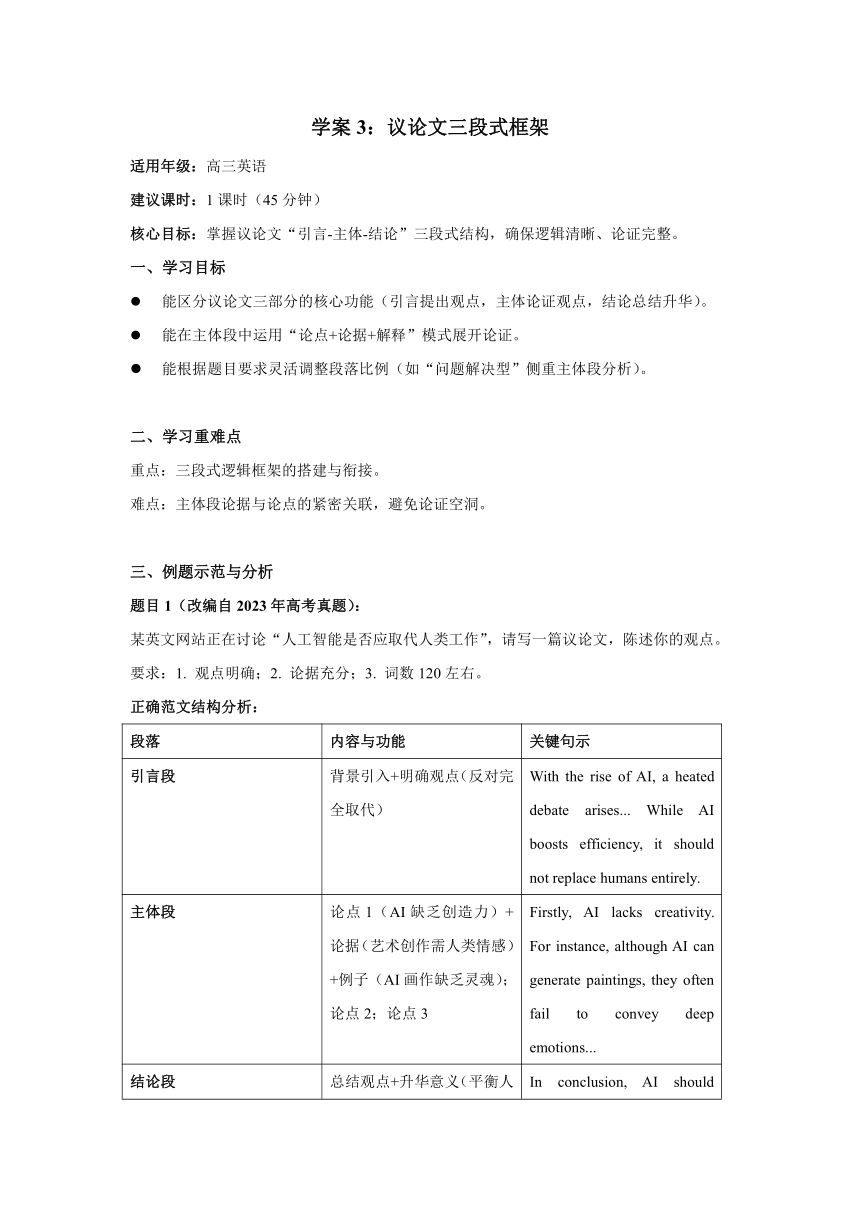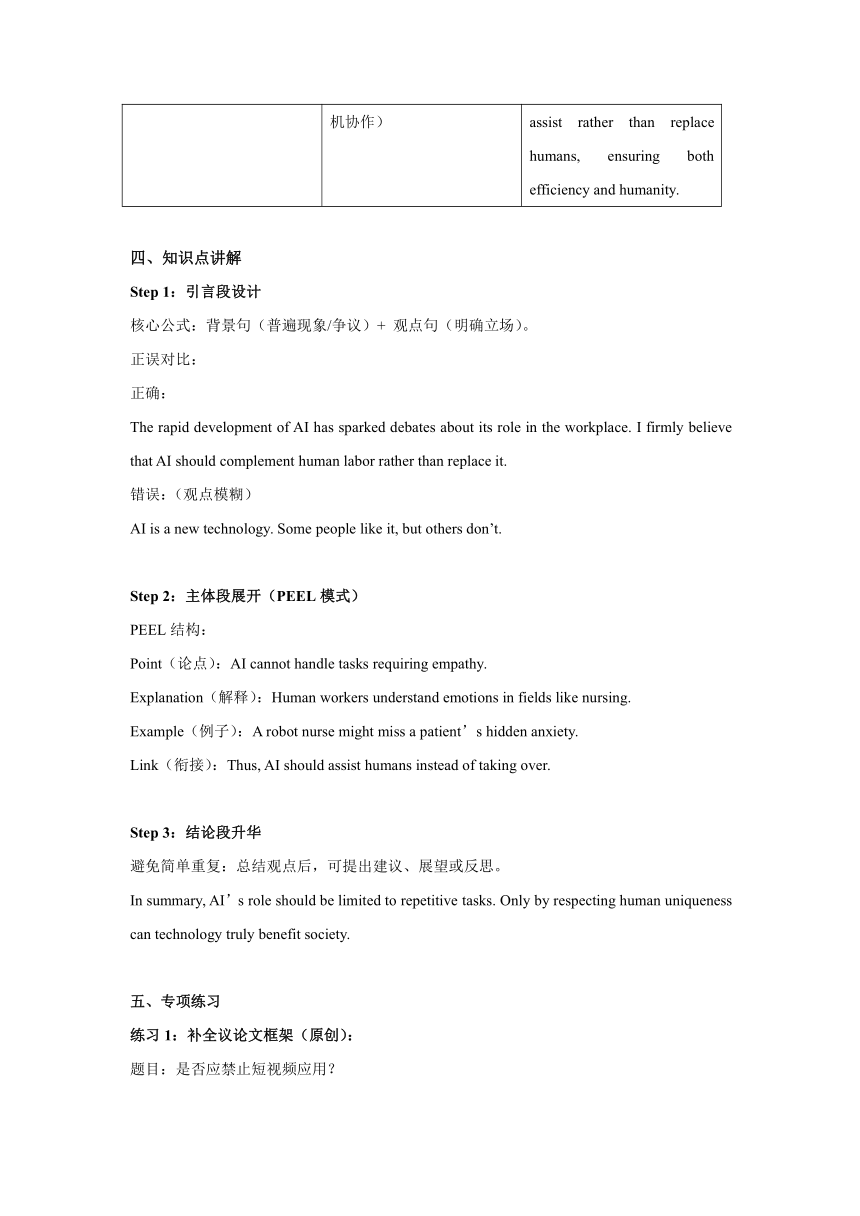2025届高三英语复习应用文写作学案(三)议论文三段式框架
文档属性
| 名称 | 2025届高三英语复习应用文写作学案(三)议论文三段式框架 |  | |
| 格式 | docx | ||
| 文件大小 | 24.5KB | ||
| 资源类型 | 教案 | ||
| 版本资源 | 人教版(2019) | ||
| 科目 | 英语 | ||
| 更新时间 | 2025-02-05 13:10:47 | ||
图片预览


文档简介
学案3:议论文三段式框架
适用年级:高三英语
建议课时:1课时(45分钟)
核心目标:掌握议论文“引言-主体-结论”三段式结构,确保逻辑清晰、论证完整。
一、学习目标
能区分议论文三部分的核心功能(引言提出观点,主体论证观点,结论总结升华)。
能在主体段中运用“论点+论据+解释”模式展开论证。
能根据题目要求灵活调整段落比例(如“问题解决型”侧重主体段分析)。
二、学习重难点
重点:三段式逻辑框架的搭建与衔接。
难点:主体段论据与论点的紧密关联,避免论证空洞。
三、例题示范与分析
题目1(改编自2023年高考真题):
某英文网站正在讨论“人工智能是否应取代人类工作”,请写一篇议论文,陈述你的观点。
要求:1. 观点明确;2. 论据充分;3. 词数120左右。
正确范文结构分析:
段落 内容与功能 关键句示
引言段 背景引入+明确观点(反对完全取代) With the rise of AI, a heated debate arises... While AI boosts efficiency, it should not replace humans entirely.
主体段 论点1(AI缺乏创造力)+论据(艺术创作需人类情感)+例子(AI画作缺乏灵魂);论点2;论点3 Firstly, AI lacks creativity. For instance, although AI can generate paintings, they often fail to convey deep emotions...
结论段 总结观点+升华意义(平衡人机协作) In conclusion, AI should assist rather than replace humans, ensuring both efficiency and humanity.
四、知识点讲解
Step 1:引言段设计
核心公式:背景句(普遍现象/争议)+ 观点句(明确立场)。
正误对比:
正确:
The rapid development of AI has sparked debates about its role in the workplace. I firmly believe that AI should complement human labor rather than replace it.
错误:(观点模糊)
AI is a new technology. Some people like it, but others don’t.
Step 2:主体段展开(PEEL模式)
PEEL结构:
Point(论点):AI cannot handle tasks requiring empathy.
Explanation(解释):Human workers understand emotions in fields like nursing.
Example(例子):A robot nurse might miss a patient’s hidden anxiety.
Link(衔接):Thus, AI should assist humans instead of taking over.
Step 3:结论段升华
避免简单重复:总结观点后,可提出建议、展望或反思。
In summary, AI’s role should be limited to repetitive tasks. Only by respecting human uniqueness can technology truly benefit society.
五、专项练习
练习1:补全议论文框架(原创):
题目:是否应禁止短视频应用?
引言段(补全观点句):
Short video apps like TikTok have gained massive popularity. __________________________.
参考答案:(教师使用时,可以删掉答案)
However, I argue that they should be regulated rather than banned completely.
练习2:找出主体段逻辑问题(原创,模拟学生习作):
论点:短视频浪费时间。
论据:Many students use TikTok for hours.
参考答案:(教师使用时,可以删掉答案)
缺乏解释(未说明“浪费时间”的具体后果,如影响学习或健康)。
六、综合训练
写作任务:
某英文报社举办“纸质书vs电子书”讨论,请写一篇议论文:
选择一方观点;
提供至少两个论据支持。
学生任务:
用表格列出三段式提纲(论点、论据、例子);
限时20分钟完成写作,并标注PEEL结构。
七、二次创作
修改任务:(教师可以在此处添加一篇不合适习作)
要求学生用红笔标出遗漏的任务点,并补充缺失段落;
对比原文与修改文,总结经验。
不合理写作示例:
AI is everywhere now. It can drive cars and answer questions. Some people think AI is good. But others worry about jobs. I think AI is helpful.
写作偏差分析:
结构缺失:无明确引言段和结论段,主体段未分论点。
论证空洞:仅陈述现象,未提供论据或例子。
修改任务:
用红笔标出结构问题,并补充PEEL结构;
修改示例:
With AI reshaping industries, debates over its impact intensify. I believe AI should enhance, not replace, human roles. (引言段)
Firstly, AI lacks emotional intelligence. For example, in healthcare, doctors comfort patients, while robots merely analyze data. (论点+例子)
Secondly, AI cannot adapt to unexpected situations. During the 2020 pandemic, human nurses creatively solved PPE shortages, which machines could not. (论据)
In conclusion, AI should serve as a tool, allowing humans to focus on tasks requiring compassion and creativity. (结论段)
八、课后巩固
1. 真题实战:分析2022年新高考Ⅰ卷议论文题目:
“Online learning: convenience vs. effectiveness.”
要求:按三段式结构列出提纲(论点:线上学习效率低;论据:自律性要求高、互动不足)。
2. 结构诊断:收集学生习作,归类常见结构问题(如“论点模糊”“结论缺失”)。
学案设计说明:通过框架模板化、正反例对比与结构诊断训练,将抽象的议论文写作转化为可操作的步骤,解决“结构混乱”的核心痛点。
适用年级:高三英语
建议课时:1课时(45分钟)
核心目标:掌握议论文“引言-主体-结论”三段式结构,确保逻辑清晰、论证完整。
一、学习目标
能区分议论文三部分的核心功能(引言提出观点,主体论证观点,结论总结升华)。
能在主体段中运用“论点+论据+解释”模式展开论证。
能根据题目要求灵活调整段落比例(如“问题解决型”侧重主体段分析)。
二、学习重难点
重点:三段式逻辑框架的搭建与衔接。
难点:主体段论据与论点的紧密关联,避免论证空洞。
三、例题示范与分析
题目1(改编自2023年高考真题):
某英文网站正在讨论“人工智能是否应取代人类工作”,请写一篇议论文,陈述你的观点。
要求:1. 观点明确;2. 论据充分;3. 词数120左右。
正确范文结构分析:
段落 内容与功能 关键句示
引言段 背景引入+明确观点(反对完全取代) With the rise of AI, a heated debate arises... While AI boosts efficiency, it should not replace humans entirely.
主体段 论点1(AI缺乏创造力)+论据(艺术创作需人类情感)+例子(AI画作缺乏灵魂);论点2;论点3 Firstly, AI lacks creativity. For instance, although AI can generate paintings, they often fail to convey deep emotions...
结论段 总结观点+升华意义(平衡人机协作) In conclusion, AI should assist rather than replace humans, ensuring both efficiency and humanity.
四、知识点讲解
Step 1:引言段设计
核心公式:背景句(普遍现象/争议)+ 观点句(明确立场)。
正误对比:
正确:
The rapid development of AI has sparked debates about its role in the workplace. I firmly believe that AI should complement human labor rather than replace it.
错误:(观点模糊)
AI is a new technology. Some people like it, but others don’t.
Step 2:主体段展开(PEEL模式)
PEEL结构:
Point(论点):AI cannot handle tasks requiring empathy.
Explanation(解释):Human workers understand emotions in fields like nursing.
Example(例子):A robot nurse might miss a patient’s hidden anxiety.
Link(衔接):Thus, AI should assist humans instead of taking over.
Step 3:结论段升华
避免简单重复:总结观点后,可提出建议、展望或反思。
In summary, AI’s role should be limited to repetitive tasks. Only by respecting human uniqueness can technology truly benefit society.
五、专项练习
练习1:补全议论文框架(原创):
题目:是否应禁止短视频应用?
引言段(补全观点句):
Short video apps like TikTok have gained massive popularity. __________________________.
参考答案:(教师使用时,可以删掉答案)
However, I argue that they should be regulated rather than banned completely.
练习2:找出主体段逻辑问题(原创,模拟学生习作):
论点:短视频浪费时间。
论据:Many students use TikTok for hours.
参考答案:(教师使用时,可以删掉答案)
缺乏解释(未说明“浪费时间”的具体后果,如影响学习或健康)。
六、综合训练
写作任务:
某英文报社举办“纸质书vs电子书”讨论,请写一篇议论文:
选择一方观点;
提供至少两个论据支持。
学生任务:
用表格列出三段式提纲(论点、论据、例子);
限时20分钟完成写作,并标注PEEL结构。
七、二次创作
修改任务:(教师可以在此处添加一篇不合适习作)
要求学生用红笔标出遗漏的任务点,并补充缺失段落;
对比原文与修改文,总结经验。
不合理写作示例:
AI is everywhere now. It can drive cars and answer questions. Some people think AI is good. But others worry about jobs. I think AI is helpful.
写作偏差分析:
结构缺失:无明确引言段和结论段,主体段未分论点。
论证空洞:仅陈述现象,未提供论据或例子。
修改任务:
用红笔标出结构问题,并补充PEEL结构;
修改示例:
With AI reshaping industries, debates over its impact intensify. I believe AI should enhance, not replace, human roles. (引言段)
Firstly, AI lacks emotional intelligence. For example, in healthcare, doctors comfort patients, while robots merely analyze data. (论点+例子)
Secondly, AI cannot adapt to unexpected situations. During the 2020 pandemic, human nurses creatively solved PPE shortages, which machines could not. (论据)
In conclusion, AI should serve as a tool, allowing humans to focus on tasks requiring compassion and creativity. (结论段)
八、课后巩固
1. 真题实战:分析2022年新高考Ⅰ卷议论文题目:
“Online learning: convenience vs. effectiveness.”
要求:按三段式结构列出提纲(论点:线上学习效率低;论据:自律性要求高、互动不足)。
2. 结构诊断:收集学生习作,归类常见结构问题(如“论点模糊”“结论缺失”)。
学案设计说明:通过框架模板化、正反例对比与结构诊断训练,将抽象的议论文写作转化为可操作的步骤,解决“结构混乱”的核心痛点。
